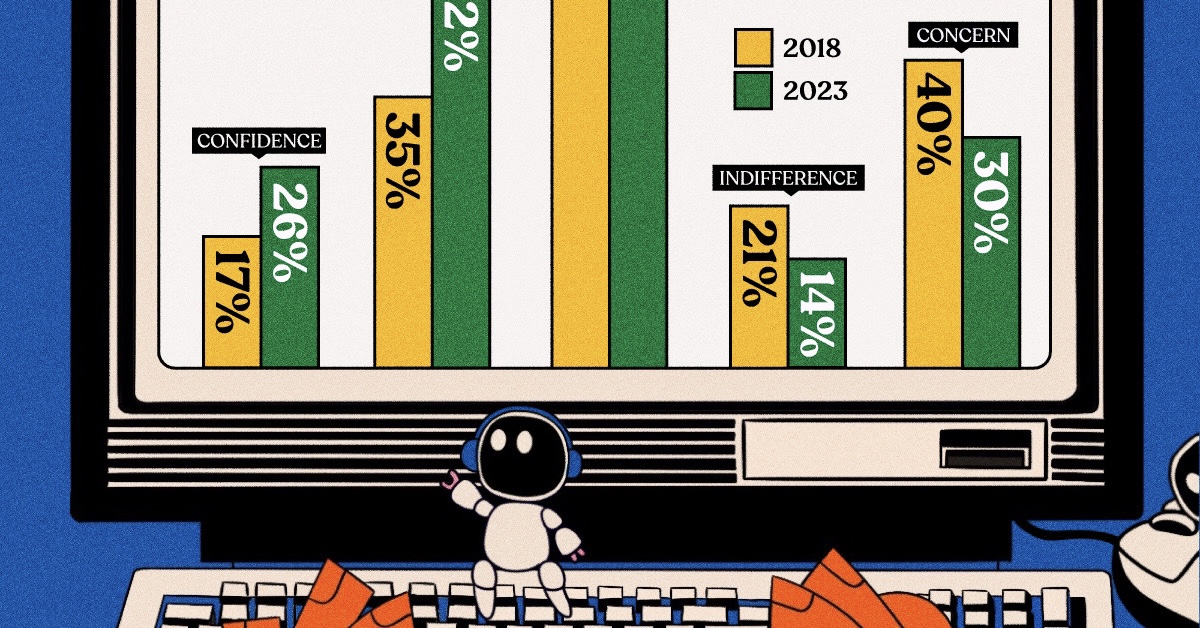AI
Charted: Changing Sentiments Towards AI in the Workplace

Is generative AI the catalyst for the next industrial revolution? Or is it a flash in the pan? Is the entire workforce destined to become AI makers and managers?
It’s possible that one, all, or none of these options could be correct. But despite how fast large language models (LLMs) and tools have grown the popularity of artificial intelligence, one thing that is clear is that there are no quick or easy answers.
Amidst all this uncertainty, opinions on how we use AI in the workplace have evolved. Recent survey data from Boston Consulting Group (BCG) reveals how the labor force feels about AI in the workplace today, compared to how they felt five years ago.
The consultancy surveyed 13,000 people (C-suite leaders, managers, and frontline employees) in 18 different countries for the results, and divided their top two responses into five categories: Curiosity, Optimism, Concern, Confidence, and Indifference.
More Optimism, Less Caution Around AI
General curiosity about AI remains almost unchanged (at 60%) since 2018.
Meanwhile, despite how rapidly AI has advanced in the last five years, or perhaps because of it, more than 50% of workers surveyed are optimistic about AI’s impact on work, a 17 percentage point (p.p.) increase from 2018.
And though 30% remain concerned about AI, this fell 10 p.p. over the same time period.
| Sentiment towards AI | 2018 | 2023 |
|---|---|---|
| Curiosity | 60% | 61% |
| Optimism | 35% | 52% |
| Concern | 40% | 30% |
| Confidence | 17% | 26% |
| Indifference | 21% | 14% |
Clearly, respondents perceive AI in the workplace far more positively now than they did in 2018. But that’s not all. The respondents’ confidence in how AI can influence their work has also increased (+5 p.p.) and indifference towards it has shrunk significantly (-7 p.p.).
Given the explosive growth in generative AI since the end of 2022—ChatGPT gets 1.8 billion visitors a month—it’s not surprising that workers are far more aware of AI compared to just five years ago.
Optimistic Leaders, Cautious Employees
As with any survey data, the devil is in the details. BCG notes that the sentiments between rungs on the company ladder differ sharply around AI.
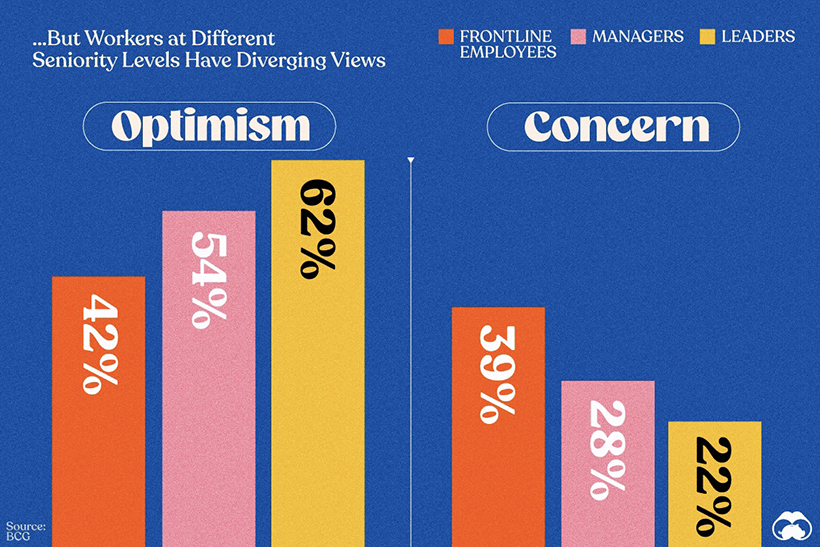
While two-thirds of polled leaders are optimistic about AI in 2023, less than half of polled frontline employees shared the same sentiment. Frontline employees were also the biggest group that responded with concern (nearly 40%).
Importantly, frontline employees are almost as optimistic as they are concerned about AI in the workplace.
| Position | Optimism | Concern |
|---|---|---|
| Leaders | 62% | 22% |
| Managers | 54% | 28% |
| Frontline Employees | 42% | 39% |
Managers were closer to leaders in their AI optimism, though some experts believe their jobs might actually be the most at risk of being replaced all together.
More Use, More Optimism Around AI
With ChatGPT reaching 100 million active users just two months after launching, it’s clear that more and more people are experimenting with generative AI.
In BCG’s poll, regular AI users—categorized as people who use it at least once a week for work—are nearly three times more optimistic than concerned about AI’s impact on their work in 2023.
| AI Use Level | Optimism | Concern |
|---|---|---|
| Regular | 62% | 22% |
| Rare | 55% | 27% |
| None | 36% | 42% |
Even rare users are two times more optimistic than cautious, with the non-user category registering the most concern.
Which brings us to who these regular users are.
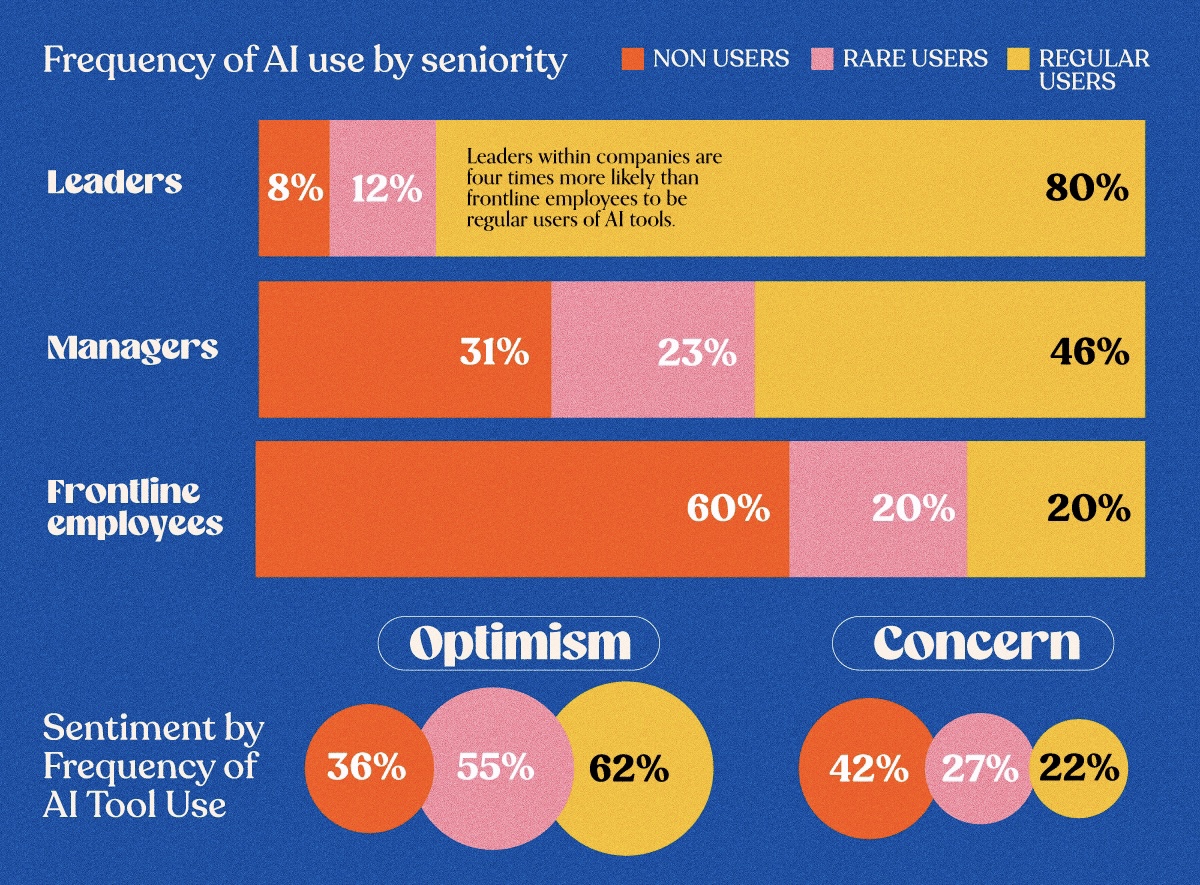
A staggering 80% of the leaders polled say they’re already regular users of AI, compared to 46% managers and 20% frontline employees.
While eyebrow-raising, these figures are not surprising.
People in leadership positions tend to have a mandate to stay ahead of the curve on current business trends, and along with their less strictly defined roles, have more freedom to try, use, and adopt AI tools while they formulate policies for their workplace.
| Position | Regular User | Rare User | Nonuser |
|---|---|---|---|
| Leaders | 80% | 12% | 8% |
| Managers | 46% | 23% | 31% |
| Frontline Employees | 20% | 20% | 60% |
At the same time, AI tools may not be green-lit en masse in many workplaces yet, preventing frontline employees from giving them a go.
So Is AI Coming For Jobs or Not?
Regardless of how definitively one can make a claim about artificial intelligence taking away people’s jobs, the survey respondents were unanimous that AI in the workplace will have some kind of an impact on their employment.

Slightly more than one-third felt that their job is in jeopardy as of 2023, while an overwhelming 86% polled said they needed training to adapt to how AI will transform their work.
With how fast the field is currently transforming, upskilling could be the safest path to follow as the AI revolution unfolds.
Where Does This Data Come From?
Source: The AI at Work: What People Are Saying report from the Boston Consulting Group.
Technology
Mapped: Global Sentiment on AI
This infographic shows public perception of AI all over the globe and how this sentiment is affected by where you live.
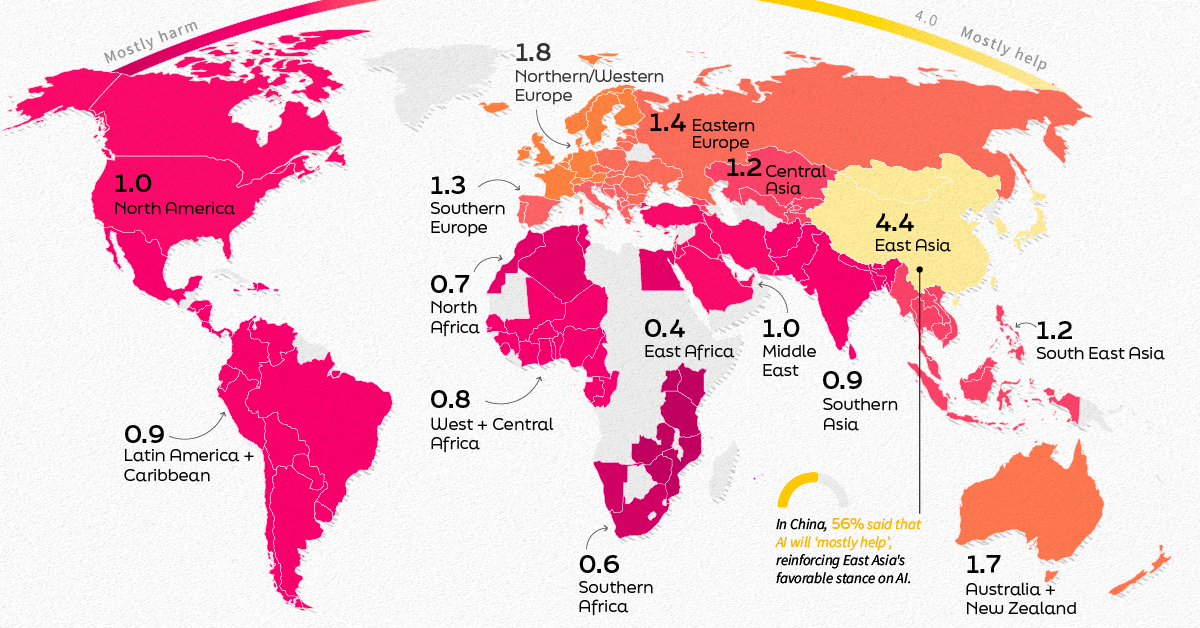

Global Sentiment on AI
Artificial intelligence (AI) has become a revolutionary force with the potential to transform many aspects of our daily lives. So understanding how the average person feels about this technology is essential as it integrates further into society.
In this graphic sponsored by Lloyd’s Register Foundation, we explore the findings of the World Risk Poll 2021: A Digital World.
The World’s Opinion is Divided
In the poll, which had 125,000 respondents in 121 countries, people were asked if AI would ‘mostly help’ or it would ‘mostly hurt‘ people in their home country over the next 20 years.
We’ve looked at the ratio of these responses below.
A higher ratio above 1.0 indicates that more people think AI could ‘mostly help’, while a ratio below 1.0 suggests that the population has more skepticism towards the technology.
Globally, the average ratio is 1.4, but significant differences can be seen when looking at each individual region.
| Region | Ratio |
|---|---|
| East Asia | 4.4 |
| Northern/Western Europe | 1.8 |
| Australia and New Zealand | 1.7 |
| Eastern Europe | 1.4 |
| Southern Europe | 1.3 |
| Central Asia | 1.2 |
| South East Asia | 1.2 |
| Middle East | 1.0 |
| North America | 1.0 |
| Latin America & Caribbean | 0.9 |
| South Asia | 0.9 |
| Central/Western Africa | 0.8 |
| North Africa | 0.7 |
| Southern Africa | 0.6 |
| Eastern Africa | 0.4 |
Notably, public opinion among the biggest economies appears split.
When we dug into the data, we saw that the U.S. showed skepticism towards AI with a ratio of 0.9. In this case, the potential loss of jobs could possibly be the leading cause of apprehension.
On the other hand, China expressed a ratio of 4.5, meaning for every 1 respondent that believes AI will ‘mostly harm’, 4.5 said AI would ‘mostly help’.
Why is AI So Polarizing?
AI has always been a divisive subject, and even the media can’t settle on whether AI is akin to the chaotic and malevolent Ultron or the caring and cat-obsessed Lt. Cmdr Data.
Consequently, it’s not just a person’s nationality or media consumption that impacts their stance on AI. A person’s life experience may also play a role in their perception of AI, more notably when it comes to religious views or access to the internet:
| View | Refused/Don't Know (%) | Neither (%) | Don’t Have Opinion (%) | Mostly Harm (%) | Mostly Help (%) |
|---|---|---|---|---|---|
| Has Access to the Internet | 5% | 3% | 22% | 26% | 44% |
| Do Not Have Access to the Internet | 15% | 2% | 23% | 32% | 28% |
| Religion is Important | 9% | 1% | 24% | 34% | 32% |
| Religion is Not Important | 7% | 4% | 20% | 21% | 48% |
| Has Experienced Discrimination | 6% | 3% | 21% | 35% | 35% |
| Has Not Experienced Discrimination | 9% | 2% | 24% | 32% | 33% |
Artificial intelligence has many philosophical ramifications, so it’s no surprise that only 32% of those who consider religion important believe AI will help. Conversely, 48% of non-religious people believe AI will ‘mostly help’.
In 16 countries, the percentage of people who say AI will ‘mostly harm’ was higher among those who had experienced discrimination based on their race/nationality, skin color, or sex, compared to those who had not. Notably, these include three Northern European countries where overall perceptions of AI are among the most positive in the world: Norway, Denmark, and Sweden.
An Uncertain Future
Even though 39% of global respondents believe AI will ‘mostly help’ in the next 20 years, only 27% of those people believe they would feel comfortable behind the wheel of a self-driving car. This suggests that while people may be ready for AI as a tool, they may not be ready for it to control large parts of their life.
With this in mind, understanding public opinion is crucial for policymakers and industry leaders to then shape the development and deployment of AI technologies in a manner that addresses these concerns.
Lloyd’s Register Foundation has created the World Risk Poll 2021 to help engineer a safer world, but the scope of this study goes beyond AI and personal data. In part two of this series, we’ll explore the World Risk Poll 2021: Safe At Work and unearth some startling trends regarding workplace harassment.

Learn more about the risks faced by ordinary people around the globe. Download the free report here.

-
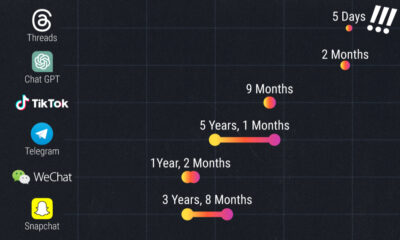
 apps5 days ago
apps5 days agoHow Long it Took for Popular Apps to Reach 100 Million Users
Threads reached 100 million users in just five days. Here is a timeline of how long other popular platforms took to reach the milestone.
-

 AI1 week ago
AI1 week agoCharted: Changing Sentiments Towards AI in the Workplace
Opinions about using AI in the workplace have undergone a transformation from 2018, and so have the AI tools themselves.
-
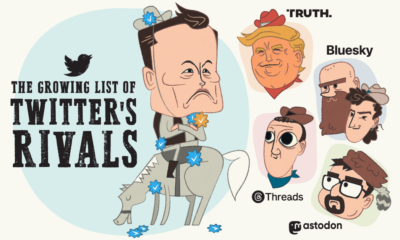
 Technology2 weeks ago
Technology2 weeks agoMeet the Competing Apps Battling for Twitter’s Market Share
Discover the five rising apps eating away at Twitter’s market share, from Meta’s new Threads app to the open-source platforms BlueSky and Mastodon.
-

 Technology1 month ago
Technology1 month agoRanked: The Most Innovative Companies in 2023
Which companies prioritize innovation the most? This infographic highlights BCG’s 2023 Most Innovative Companies ranking.
-

 Technology1 month ago
Technology1 month agoRanked: America’s Largest Semiconductor Companies
This graphic visualizes the market capitalizations of America’s 15 largest semiconductor companies.
-

 Technology2 months ago
Technology2 months agoNvidia Joins the Trillion Dollar Club
America’s biggest chipmaker Nvidia has joined the trillion dollar club as advancements in AI move at lightning speed.
-

 Stocks3 weeks ago
Stocks3 weeks agoWhat are Top Investment Managers Holding in Their Portfolios?
-
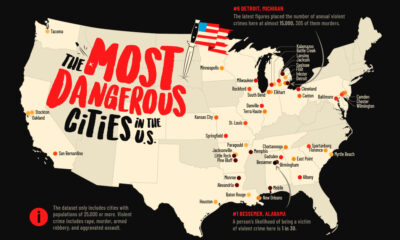
 Crime1 week ago
Crime1 week agoMapped: The Most Dangerous Cities in the U.S.
-

 Markets3 weeks ago
Markets3 weeks agoChart: U.S. Home Price Growth Over 50 Years
-
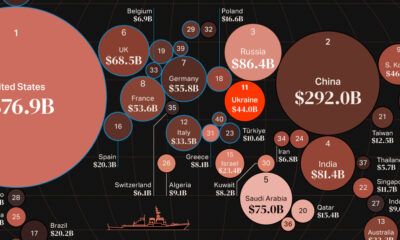
 Countries7 days ago
Countries7 days agoMapped: World’s Top 40 Largest Military Budgets
-
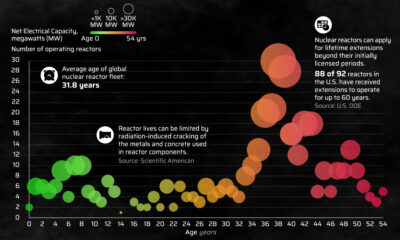
 Energy3 weeks ago
Energy3 weeks agoHow Old Are the World’s Nuclear Reactors?
-
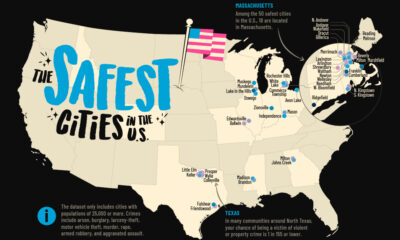
 Crime6 days ago
Crime6 days agoMapped: The Safest Cities in the U.S.
-

 Energy3 weeks ago
Energy3 weeks agoHow Big is the Market for Crude Oil?
-

 apps5 days ago
apps5 days agoHow Long it Took for Popular Apps to Reach 100 Million Users

